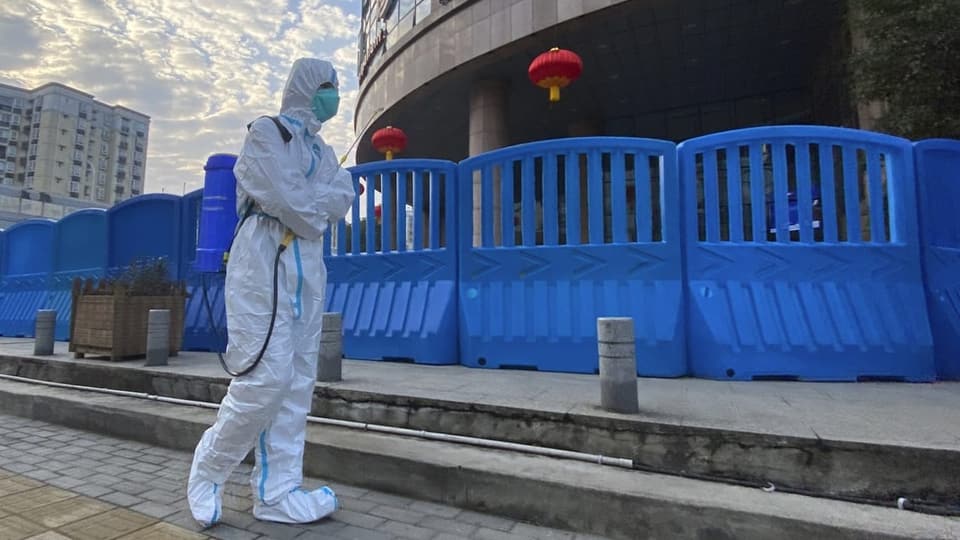China has withheld information about the possible natural origin of the virus. The WHO calls the lack of transparency “inexcusable”.

The Huanan market in the middle of the metropolis of Wuhan was at the center of the first corona outbreak: “The cases that are known are all around this market,” says Bernese virologist Volker Thiel. Since the beginning of the pandemic, he has been researching the coronavirus.
Accidental data discovery, great gain in knowledge
Now so-called environmental samples have appeared. The genetic data that can be read from these samples were available online for a short time on the research server GISAID, uploaded by Chinese researchers from the local epidemic institute CCDC. The French researcher Florence Débarre discovered it on the server rather by chance, and then evaluated it with colleagues.
I would be surprised if China itself does not want to know where the infections come from.
These are samples that were taken three years ago, right after the outbreak of the pandemic, in Huanan Market: swabs from walls, cages, in drains, so-called environmental samples. Now it is clear: China has been withholding this revealing data all along and from the world.
The WHO now reacts unusually clearly in the journal “Science”, calls for more transparency, and condemns the lack of it. “I can imagine that the WHO feels led around by the nose,” says Thiel. And further: “It would surprise me if China does not want to know for itself where the infections come from.”
You still don’t know everything
China is a modern research country and has the technical capabilities and knowledge to search for information in the right place with the right methods. From the point of view of virology, it is almost a matter of course where it is worth looking. Thiel says: “I can’t know for sure, but I think they have taken other samples besides these that we don’t know about yet.”
On live animals at the market, for example, on farms in the outskirts of the city. Thiel: “And if there is a suspicion that the virus was on certain farms, how did it get there?” Connections to wildlife must be clarified, Thiel continued.
I can imagine that the WHO is very disappointed.
The WHO now emphasizes, at least between the lines, that China can hardly pretend that there are no relevant samples at all these obvious places and times. “It’s unusually clear. And I can also imagine that the WHO is very disappointed. It was probably thought that China was relatively open,” says Thiel. However, this does not seem to be the case.
“The virus was there”
The WHO also emphasizes that key details are still missing about the work being done at the Wuhan Institute of Virology. The call for China to cooperate transparently with other countries and the WHO is therefore aimed at both possible starting points for the pandemic: the market and the laboratory.
The current state of knowledge, however, can be summarized as follows: “We have clear evidence that the virus was on this market. We also know that the animals that are susceptible to the virus were also there,” says virologist Thiel.
News
Drug-Coated Neural Implants Reduce Immune Rejection
Summary: A new study shows that coating neural prosthetic implants with the anti-inflammatory drug dexamethasone helps reduce the body’s immune response and scar tissue formation. This strategy enhances the long-term performance and stability of electrodes [...]
Scientists discover cancer-fighting bacteria that ‘soak up’ forever chemicals in the body
A family of healthy bacteria may help 'soak up' toxic forever chemicals in the body, warding off their cancerous effects. Forever chemicals, also known as PFAS (per- and polyfluoroalkyl substances), are toxic chemicals that [...]
Johns Hopkins Researchers Uncover a New Way To Kill Cancer Cells
A new study reveals that blocking ribosomal RNA production rewires cancer cell behavior and could help treat genetically unstable tumors. Researchers at the Johns Hopkins Kimmel Cancer Center and the Department of Radiation Oncology and Molecular [...]
AI matches doctors in mapping lung tumors for radiation therapy
In radiation therapy, precision can save lives. Oncologists must carefully map the size and location of a tumor before delivering high-dose radiation to destroy cancer cells while sparing healthy tissue. But this process, called [...]
Scientists Finally “See” Key Protein That Controls Inflammation
Researchers used advanced microscopy to uncover important protein structures. For the first time, two important protein structures in the human body are being visualized, thanks in part to cutting-edge technology at the University of [...]
AI tool detects 9 types of dementia from a single brain scan
Mayo Clinic researchers have developed a new artificial intelligence (AI) tool that helps clinicians identify brain activity patterns linked to nine types of dementia, including Alzheimer's disease, using a single, widely available scan—a transformative [...]
Is plastic packaging putting more than just food on your plate?
New research reveals that common food packaging and utensils can shed microscopic plastics into our food, prompting urgent calls for stricter testing and updated regulations to protect public health. Beyond microplastics: The analysis intentionally [...]
Aging Spreads Through the Bloodstream
Summary: New research reveals that aging isn’t just a local cellular process—it can spread throughout the body via the bloodstream. A redox-sensitive protein called ReHMGB1, secreted by senescent cells, was found to trigger aging features [...]
AI and nanomedicine find rare biomarkers for prostrate cancer and atherosclerosis
Imagine a stadium packed with 75,000 fans, all wearing green and white jerseys—except one person in a solid green shirt. Finding that person would be tough. That's how hard it is for scientists to [...]
Are Pesticides Breeding the Next Pandemic? Experts Warn of Fungal Superbugs
Fungicides used in agriculture have been linked to an increase in resistance to antifungal drugs in both humans and animals. Fungal infections are on the rise, and two UC Davis infectious disease experts, Dr. George Thompson [...]
Scientists Crack the 500-Million-Year-Old Code That Controls Your Immune System
A collaborative team from Penn Medicine and Penn Engineering has uncovered the mathematical principles behind a 500-million-year-old protein network that determines whether foreign materials are recognized as friend or foe. How does your body [...]
Team discovers how tiny parts of cells stay organized, new insights for blocking cancer growth
A team of international researchers led by scientists at City of Hope provides the most thorough account yet of an elusive target for cancer treatment. Published in Science Advances, the study suggests a complex signaling [...]
Nanomaterials in Ophthalmology: A Review
Eye diseases are becoming more common. In 2020, over 250 million people had mild vision problems, and 295 million experienced moderate to severe ocular conditions. In response, researchers are turning to nanotechnology and nanomaterials—tools that are transforming [...]
Natural Plant Extract Removes up to 90% of Microplastics From Water
Researchers found that natural polymers derived from okra and fenugreek are highly effective at removing microplastics from water. The same sticky substances that make okra slimy and give fenugreek its gel-like texture could help [...]
Instant coffee may damage your eyes, genetic study finds
A new genetic study shows that just one extra cup of instant coffee a day could significantly increase your risk of developing dry AMD, shedding fresh light on how our daily beverage choices may [...]
Nanoneedle patch offers painless alternative to traditional cancer biopsies
A patch containing tens of millions of microscopic nanoneedles could soon replace traditional biopsies, scientists have found. The patch offers a painless and less invasive alternative for millions of patients worldwide who undergo biopsies [...]





















